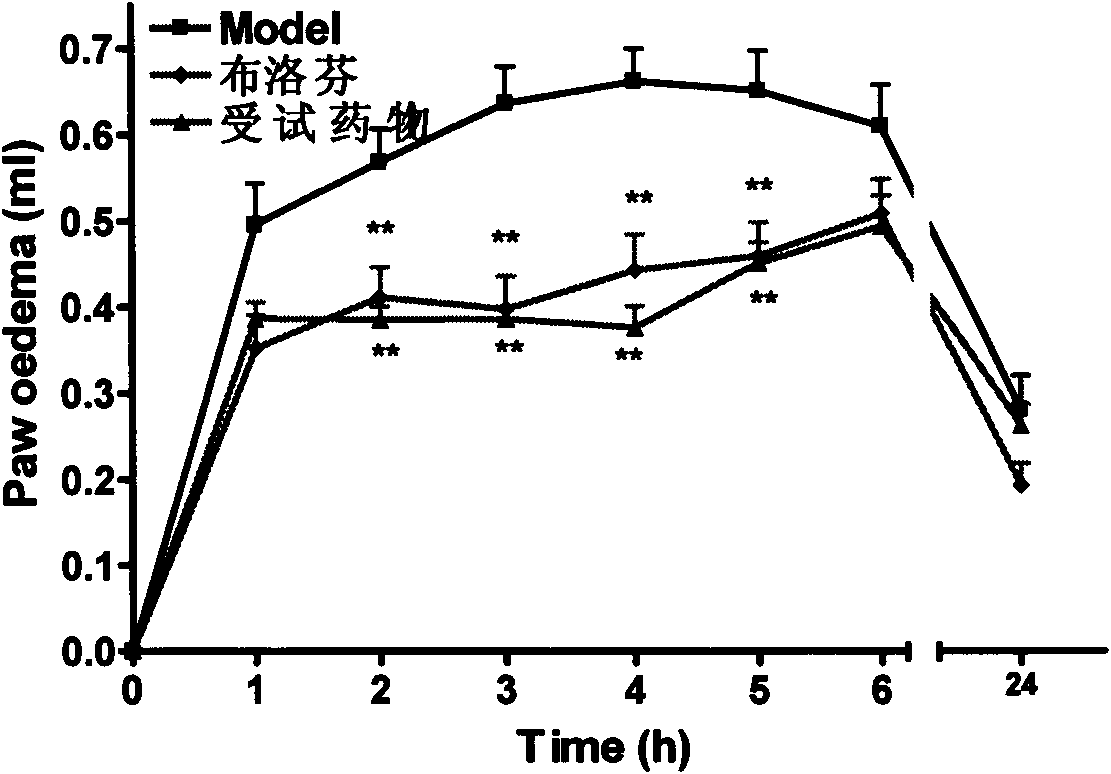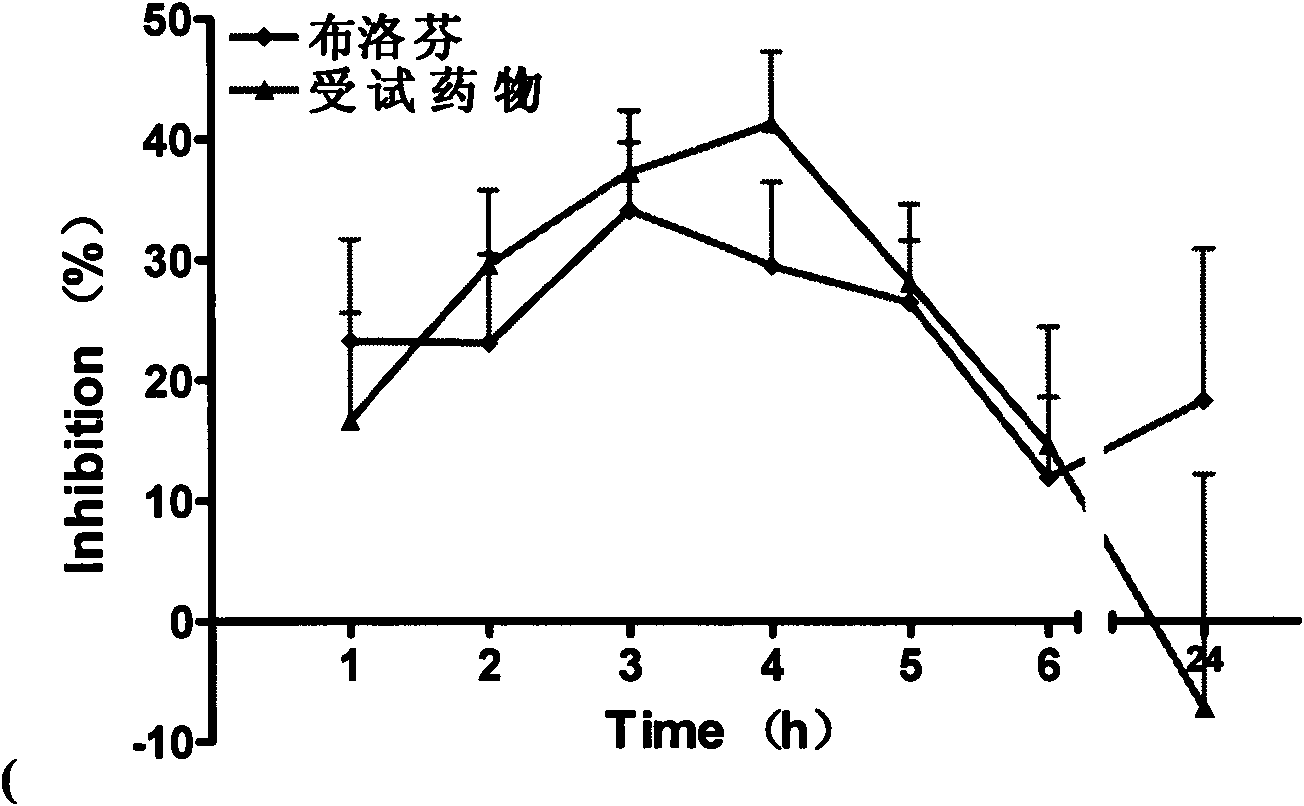Medical use of (S)-3-fluoro-2-(4-isobutyl phenyl) propionic acid
A technology of isobutylbenzene and propionic acid, applied in the field of pharmacy
- Summary
- Abstract
- Description
- Claims
- Application Information
AI Technical Summary
Problems solved by technology
Method used
Image
Examples
Embodiment 1
[0018] Example 1 Synthesis of (S)-3-fluoro-2-(4-isobutylbenzene) propionic acid
[0019]
[0020] In a round bottom flask, combine optically pure (R)-1-(1-fluoro-3-enyl-2-butyl)-4-isobutylbenzene (41.7 mg) and sodium periodate (213.8 mg) ) was dissolved in 2 mL of a mixed solvent of carbon tetrachloride and acetonitrile (1:1), then an aqueous solution of hydrated ruthenium trichloride (2.1 mg) (1.5 mL) was added, stirred at room temperature for 1.5 hours, and ether (5 mL) was added. ) and saturated aqueous sodium bicarbonate (5 mL). Extract with aqueous sodium bicarbonate solution (5 mL x 5), combine the aqueous phases, slowly add concentrated hydrochloric acid at zero degrees Celsius to adjust the pH to 1, extract with dichloromethane (5 mL x 4), combine the organic phases, anhydrous Dry with sodium sulfate, remove the solvent under reduced pressure, and obtain the synthesis of the target product (S)-3-fluoro-2-(4-isobutylbenzene)propionic acid. White solid, 91% yield, [...
Embodiment 2
[0021] Anti-inflammatory effect of embodiment 2 (S)-3-fluoro-2-(4-isobutylphenyl) propionic acid
[0022] Model Selection: Carrageenan-Induced Acute Inflammation Model of Paw Swelling in Rats
[0023] Rationale: Carrageenan increases prostaglandin (PG) synthesis in the inflammatory locale, and together with vasoactive amines such as histamine, 5-HT, and kinins, induces edema.
[0024] Sample preparation:
[0025] Positive control drug: ibuprofen
[0026] Preparation method: Dissolve and dilute with 0.5% CMC to a white cloudy liquid.
[0027] Drug dosage: 30mg / kg
[0028] Drug administration volume: 1ml / 100g
[0029] Drug Administration Mode: i.g.
[0030] Drug under test: (S)-3-fluoro-2-(4-isobutylphenyl)propionic acid
[0031] Preparation method: Dissolve and dilute with 0.5% CMC to light yellow turbid liquid.
[0032] Drug dosage: 33.6mg / kg
[0033] Drug administration volume: 1ml / 100g
[0034] Drug Administration Mode: i.g
[0035] Carrageenan (λCarrageenan) was p...
Embodiment 3
[0058] The analgesic effect of embodiment 3 (S)-3-fluoro-2-(4-isobutylphenyl) propionic acid
[0059] Model Selection: Chemical Stimulation
[0060] Basic principle: Many chemical substances, such as strong acid, strong alkali, potassium ion, bradykinin, etc., will cause pain when they come into contact with intact skin and mucous membranes. Therefore, administering certain chemical substances into animals can produce pain and create a pain model as a method for studying pain physiology and screening analgesic drugs. The mouse writhing method is one of the commonly used methods for screening analgesics. Some chemical stimulants are injected into the abdominal cavity of mice to cause deep, large-scale and long-lasting pain stimulation, causing the mice to produce a "writhing" response ( Belly concave, torso and hind legs extended, rump high). Observe the "writhing" times of mice or mice that have "writhing" reactions within 10 minutes of being given chemical stimulants, and c...
PUM
| Property | Measurement | Unit |
|---|---|---|
| Weight | aaaaa | aaaaa |
| Weight | aaaaa | aaaaa |
| Weight | aaaaa | aaaaa |
Abstract
Description
Claims
Application Information
 Login to View More
Login to View More - Generate Ideas
- Intellectual Property
- Life Sciences
- Materials
- Tech Scout
- Unparalleled Data Quality
- Higher Quality Content
- 60% Fewer Hallucinations
Browse by: Latest US Patents, China's latest patents, Technical Efficacy Thesaurus, Application Domain, Technology Topic, Popular Technical Reports.
© 2025 PatSnap. All rights reserved.Legal|Privacy policy|Modern Slavery Act Transparency Statement|Sitemap|About US| Contact US: help@patsnap.com



